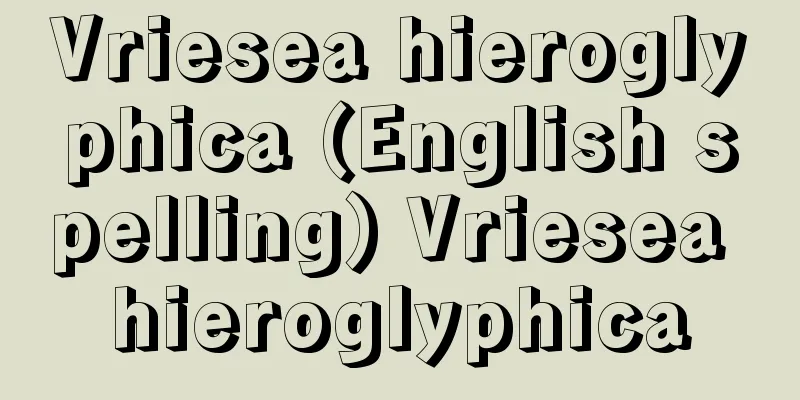Seal - Insho

|
A seal is a device that engraves patterns or letters into the surface of metal or hard minerals, and leaves an imprint on the document to guarantee the authenticity of the document. It was most widely used in China, but its origins seem to be in the ancient Orient. In ancient China, it was not called "in" but "ji" or "ji", but it is said that the First Emperor of Qin made the word "ji" (we) "chin" (my) the exclusive use of the emperor, and so made his subjects call it "in". [Fushimi Okiyoshi] ChinaThe origins of Chinese sealsThe earliest example found in Chinese documents is in the Zuo Zhuan of the Spring and Autumn Annals, an entry for the 29th year of the reign of Duke Xiang, which reads, "When the Duke returned and reached Fangcheng, Ji Wuzi took Bian. He asked Gongye about it. He pursued him and gave him a written seal, saying, "I have heard that the guardian of Bian is planning to rebel against the general, so I have led my subordinates in defeating them and have already taken possession of them. I dare to tell you." The "written seal" in this passage refers to an order sealed with the king's seal. Before the use of paper became widespread, documents were written on pieces of wood, which were then sealed with string, the seal filled with clay, and a seal was then affixed to it. These are called "mud seals" and many of these relics have been discovered since the end of the Qing dynasty. The 29th year of Duke Xiang of Lu, when the Zuo Zhuan is recorded, corresponds to the 27th year of King Ling of Zhou, 545 BC, the middle of the Spring and Autumn period. There are various styles of "seals," and the Shiwei chapter of the "Lu Shi Chunqiu" (Lu's Spring and Autumn Annals) states, "When placed on the people, it is like the coating of a seal. If a shape is used to hold it down, then it is a shape, and if a circle is used to hold it down, then it is a circle." "Coating" refers to clay, and it is said that if a square seal is pressed into it, a square shape will be created, and if a round seal is pressed into it, a round shape will be created. In fact, a large number of seals from the Spring and Autumn Period (8th century BCE to 3rd century BCE) have been discovered in the modern era, and they include square, round, and irregular shapes, and some with carved figures as well as letters. It seems that cylindrical seals were not used in China, but there are seals with multiple sides, from one to six. They are made of materials such as jade and gold, but the most common is bronze, which is most often cast, but some have letters carved into them with a chisel . Many of them have a knob on the opposite side of the seal face, which is called a "knob," and many are cast in the shape of animals. Depending on the shape, they are called "tiger knob" or "turtle knob," but there are also various other shapes such as "tile knob" and "altar knob," and even a "heavy-roof knob" shaped like a tower. [Fushimi Okiyoshi] A completed Han dynasty sealIt was during the Han dynasty that seals were most widely used in China, and the system was well established. In the early modern period, the making of seals came to be called "seal carving" and developed into a branch of art, and the "Han seal" was the model and was revered as the ideal. Although craftsmen who made "seals" naturally made an effort to create beautiful and well-formed ones, they were originally practical items and not considered art. However, in the early modern period, seal carving came to be counted as a branch of art unique to the Orient, along with poetry, calligraphy, and painting, as a hobby for readers. Seals are divided into two categories: "official seals" issued by government offices, and "private seals" made and used by private individuals. "Official seals" were not only used to seal documents, but also to prove the status of a government official by carrying one. There was a gap at the bottom of the knob of a Han seal to pass a string through, and a braided string called a "ribbon" was passed through the gap and the seal was worn on the body. A famous story is recorded in Sima Qian's Records of the Grand Historian (volume 69) about Su Qin, one of the so-called "Vertical and Horizontal Scholars" who was active at the end of the Warring States period, who planned the unification of six countries and wore the seal of the Six Ministers to show off to the people of his hometown who had been looked down upon during his unfortunate times. This is a declaration that he had been given the authority to represent the six countries. Many seals from the Han Dynasty were made of bronze, so they were not damaged even when buried underground, and many intact ones have been excavated, but the "ribbons" seem to have decayed, and to date not a single one has been found, and there are no detailed descriptions of them in documents, and their shape is unclear. It is also difficult to know whether they were hung from the shoulder like today's grand ribbons of medals, or wrapped around the waist. Seals and mud seals were still in use up until the Wei dynasty of the Three Kingdoms period and the Jin dynasty that followed, but by the end of the Northern and Southern Dynasties, the use of wooden tablets had fallen out of use and paper came to be used, with vermilion ink being pressed onto the paper, leading to major changes in size and the shape of the knobs. Seals of the Han, Wei and Jin dynasties were generally less than one inch in diameter, but many of the official seals of the Southern Dynasties and those of the Sui and Tang dynasties were more than four times that size in area. In Japan, the seals of the Nara period, all of which were imitations of the Tang Dynasty system, were also large, whether they were those of government offices, temples, or shrines. In China, during the Song and Yuan dynasties, large official seals were used. During the Yuan dynasty, seals were written in Phag-pa script instead of Chinese characters (the Qing dynasty, which was also a conquering dynasty, used both Manchu and Chinese characters on the same seal). [Fushimi Okiyoshi] The birth of seal carving artFrom the Song and Yuan dynasties, just as painting evolved from the hands of painters into literati paintings as a pastime for literati, readers also began to make seals themselves. At the end of the Yuan dynasty, Wang Mian (1335-1409) discovered a stone called huamilite that could be easily carved by anyone, even if it was not a specialized craftsman, and many literati began to carve seals. During the Ming dynasty, people who were known as masters of seal carving appeared, such as Wen Peng (1498-1573), the son of the famous Wen Zhengming. The next person to become famous after Wen Peng was He Zhen (years of birth and death unknown), who was called Wen and He. After this, seal carving developed greatly as a unique art, but in the Qing dynasty, many seal carvers emerged, mainly in Qiantang, Zhejiang Province, and they became known as the Zhejiang School, which has had a great influence to later generations. In opposition to the Zhejiang School, a major force of seal carving also emerged in Anhui Province, and they came to be known as the Wan School, after the ancient name of Anhui. The art of seal carving reached its zenith with the likes of Wu Rangzhi (1799-1870), Zhao Zhiqian (1829-1884), and Wu Changshuo (1844-1927) in the late Qing dynasty, but there was no one to succeed Wu. Qi Huang (Baishi, 1863-1957) of the People's Republic of China was given special treatment as a People's Artist and was respected, but his seal carvings, like his paintings and calligraphy, are extremely crude and cannot be compared to the masters of the Qing dynasty. The Xiling Seal Society, which was founded by Wu Changshuo and others and contributed to the development of seal carving from the end of the Qing dynasty through the Republic of China, has recently begun to take action again, and people who are not so well known to the public, such as Wang Fu'an, are now occasionally producing modest works. Just as calligraphy is said to be booming in Japan, "calligraphy" is also quite popular in China, and seal carvings are also being published in calligraphy magazines. It seems to be influenced by the fact that Japanese calligraphy is now mostly focused on design for exhibitions, and modern Chinese "calligraphy" is noticeably rough, but the same seems to be true of seal carvings, and it is sad that many of them are crude. [Fushimi Okiyoshi] JapanJapan's Ritsuryo system imported the seal system of the Sui and Tang dynasties, and the Emperor's seal (inner seal) was 3 sun (8.7 cm, 1 sun is 2.9 cm), the Daijokan's seal (outer seal) was 2.5 sun, the seals of various offices were 2 sun 2 bu, and the seals of various provinces were 2 sun. Copper seals cast by the central government were distributed. Private seals were not generally accepted. In the beginning, seals were stamped on the entire page or the entire text of a document as a proof, but gradually they came to be stamped only on key points, and from the mid-Heian period, official documents without any seals appeared. This is related to the emergence of the Kao, and signatures and Kao were used as evidence of documents instead of seals, and this became common. The fact that samurai documents from the Kamakura and Muromachi periods were completely unmarked was also due to the trend of the times, and it is thought that more importance was placed on the kao, as a symbol of personal authority, than on government seals. Contrary to the decline of official seals, private seals developed in the Middle Ages. In addition to the practice of private seals, which had been practiced to a limited extent since ancient times, the popularity of private seals from Song dynasty Zen temples was introduced to Japan during the Kamakura period, and Zen-style seals replaced kao seals and spread among the monks of the Five Mountains. They were often used as signatures for paintings and calligraphy, and library seals gradually became more common. In addition to the square, a variety of shapes appeared for the seal face, including circles, ellipses, oval coins, vases, cauldrons, diamonds, and rectangles. It was also from the Middle Ages that wood became the mainstream material for seals, and vermilion mixed with oil came to be used. The popularity of private seals also influenced the use of kao, and the print-engraved kao, which appeared in the Kamakura period, gradually came to be used more and more, and in the early modern period a method appeared in which the kao was carved into kagoji (bordered characters that outline the characters) and then pressed and filled with ink, and seals came to replace the kao, which had emerged as a substitute for the signature. Warlords in the Sengoku period liked to use various seals, which they stamped on documents they issued. These were called inbanjo (stamps), and were divided into shuinjo (red seal stamps) and kokuinjo (black seal stamps). The same seal was available in two types, red and black, with the red seal generally being considered more generous. Many of the seals used by warlords in the Sengoku period contained auspicious phrases or expressed political ideals, as well as the names of gods and Buddhas, and images of animals with spiritual or powerful powers. Some of the more famous seals are the Hojo clan's "Rokuju Oon," the Imagawa clan's "Nyoritsuryo," Oda Nobunaga's "Tenka Fubu," the Uesugi clan's "Ritsuga Shogun Jizo Marishiten Izuna Myojin," and the Takeda clan's dragon seal. Even in the early modern period, Tokugawa shoguns had two types of seals, red and black, and red seal letters and black seal letters were given to approve kokudaka (rice yield) and to prove passage to sea. The feudal lords followed suit, and seals became increasingly popular. The use of seals spread to commoners as well, and they were stamped on documents, but peasants and townspeople were not allowed to use red seals. As seals became more popular, it became necessary to register the impressions in advance for comparison in order to determine whether a seal was genuine. These registration ledgers were called seals, and the word seal used today is a variation on this. The Meiji government established the system of official seals, and it was decided that the general public should use registered personal seals instead of Kao on documents. However, simple personal seals (mitomein) and ready-made cheap stamps are usually used, and sometimes thumbprints are used instead. Although the hassle of stamps was an issue, seals have become an indispensable part of everyday life today. In addition, seal impressions are objects of appreciation as calligraphy art, and seal albums that collect impressions of old seals and seal engravers' engravings are highly valued. In addition, seals themselves are also highly valued as works of art. [Kanichi Minagawa] EuropeOrientThe origin of seals is very ancient, and their use can already be found in the Near East in the 4th millennium BC. They were mainly used to indicate royal authority, to grant approval, and as a seal, and were imprinted on clay tablets. There are two types of seals: stamps and cylinders, the latter of which are rolled onto a clay tablet to create an impression. European seals began with the introduction of Oriental seals to the eastern Mediterranean region. The earliest examples are stamp-shaped seals found on the island of Crete around 2500 BC, which feature Oriental beasts and mythological themes as well as trees and marine animals as impressions. The main materials used are lithic stone, jade, and other stones, but clay seals with human figures have also been excavated from the site of the palace of Knossos. A gold ring with an oval seal face was also discovered. A little later than Crete, the Mycenaean civilization on the Greek mainland, influenced by Crete, began to show original Mycenaean themes such as lions, people, and hunting. However, it has also been pointed out that many of the seals excavated in Mycenae were made in Crete. [Nao Tomobe] Greek and Roman periodMycenae gradually lost its power around 1200 BC, and seal production became less active, but around the 8th to 7th centuries BC, Greek cities gained power and aristocrats established their status, and demand for seals returned. During this period, scarab-shaped seals and coin-shaped seals, which had been imported from Egypt, were actively produced, and a close relationship can be seen between their designs and those of coins. Just as the owl was widely used as the symbol of Athens, sphinxes, prancing horses, and rams were popular themes for both coins and seals. During the time of Alexander, the importance of seals increased due to the need for imperial seals, but the design of Alexander's own imperial seal is unknown. Even before Alexander, high-ranking officials already had their own personal seals, but in the Roman era, people began to have portraits of themselves or their ancestors engraved on their seals, and ring-shaped personal seals engraved with images of gods, bulls, birds, masks, etc. became popular among ordinary people as well. [Nao Tomobe] From the Middle Ages onwardsBy the 13th century, a system had been established in which seals were used according to certain rules. Most matrices were made of cast copper, and the largest ones could exceed 10 centimeters in diameter. The uses of medieval seals can be broadly divided into those in which a stamp was pressed onto a document using wax, and those in which a ribbon or silk cord was attached to the end of a document and then sealed with wax. Shapes included circular, shield-shaped, and oval with pointed ends, and the subjects were diverse, including symbols, coats of arms, clergy, and buildings. However, from around the 18th century, their role as a seal gradually decreased. During the Napoleon I and Victorian eras, there was a temporary revival of highly decorative seals, but they were generally replaced by signatures and declined in use except when kept for personal preference. In modern times, seals are used mainly as a sign of guarantee or approval for companies, organizations, and individuals. [Nao Tomobe] "Outline of Seals by Fei Fuyi and Wang Rencong (1973, Zhonghua Book Company; Japanese translation: Chinese Seals by Ando Sarao, 1965, Nigensha)" [Reference items] | | |Source: Shogakukan Encyclopedia Nipponica About Encyclopedia Nipponica Information | Legend |
|
金属や硬い鉱物の面に紋様や文字を彫りつけ、その印痕(いんこん)を文書に押し付けて残し、文書の信頼性を保証するもの。その使用がもっとも盛んだったのは中国であるが、その起源は古代オリエントだったようである。中国では古くは「印」といわず「(じ)」または「璽(じ)」といっていたが、秦(しん)の始皇帝が、「われ」ということば「朕(ちん)」を皇帝の専用にしたように「璽」は皇帝のみ、臣下は「印」とよばせるようにしたという。 [伏見冲敬] 中国中国印章の起源中国の文献にみえるもっとも早い例は、『春秋左氏伝』の襄公(じょうこう)29年の条に「公還(かえ)りて方城に及ぶとき、季武子(きぶし)、卞(べん)を取る。公冶(こうや)をして問わしむ。璽書して追いてこれに与えて曰(いわ)く、卞を守る者将(まさ)に叛(そむ)かんとするを聞き、臣、徒を帥(ひき)いて以(もっ)てこれを討じ、すでにこれを得たり。敢(あえ)て告ぐと」とある「璽書」とは王の璽をもって封じた命令書である。紙の使用が広まる以前は、木片に文書をしたため、それを紐(ひも)で封じて、封じ目に粘土を詰めて、それに印を押したのであった。これを「封泥(ふうでい)」といい、その遺物が、清(しん)朝の末期以来、大量に発見されている。なお、左伝の記事のある魯(ろ)の襄公の29年は、周の霊王の27年にあたり、紀元前545年で、春秋時代の中葉である。「璽」の様式はいろいろあり、『呂氏(りょし)春秋』の適威(てきい)編に「民の上に於(お)けるは、璽の塗(と)におけるがごとし、これを抑うるに方を以てせば則(すなわ)ち方、これを抑うるに円を以てせば則ち円なり」とある。「塗」とは粘土のことで、そこに四角の璽を押し付ければ四角の形がつき、円い璽を押せば円い形がつくといっている。事実、春秋戦国時代(前8世紀~前3世紀)の印璽が近世になって大量に発見されているが、四角いのや円いのや変形のもの、また文字だけでなく、図様を彫ったものもある。中国では「円筒印章」は用いられなかったようであるが、1面だけでなく、両面から6面に及ぶ多面の印がある。材質は玉(ぎょく)や金などもあるが、いちばん多いのは青銅で、鋳造がもっとも多いが、たがねで文字を彫りつけたものもままある。印面の反対側がつまみになっているものが多く、これを「鈕(ちゅう)」というが、動物の形を鋳出したものが多い。その形によって、「虎鈕(こちゅう)」とか「亀鈕(きちゅう)」とかよばれるが、そのほかに、「瓦鈕(がちゅう)」とか「壇鈕(だんちゅう)」とかいろいろな形があり、塔のような形をした「重屋鈕」などというのまである。 [伏見冲敬] 完成された漢代の印中国で印がもっとも盛んに用いられ、また制度が整ったのは漢代で、近世になってから印章をつくることを「篆刻(てんこく)」といって、芸術の一部門として発達するようになってから、その模範とし、理想として貴ばれたのは「漢印」であった。「印章」はもともとそれを業とする工人が、美しく整ったものを作製すべく努力をしたのはもちろんであるが、本来、実用品であって芸術とされてきたものではなかった。それが、近世になって、読書人のたしなみとして、詩、書、画とともに篆刻が東洋固有の芸術の一部門に数えられるようになったものである。 印章には官府から発給される「官印」と、私人の作製し使用する「私印」の2大別がある。「官印」は、文書の封緘(ふうかん)に用いられるだけでなく、それを所持することによって、官吏としての身分を証明するものでもあった。漢印の鈕の下部には紐(ひも)を通すすきまがあり、そこに「綬(じゅ)」とよばれる組紐を通して、その「綬」をもって身体に佩用(はいよう)するのである。戦国時代の末期に活躍した、いわゆる縦横家(じゅうおうか)の一人、蘇秦(そしん)が、六つの国の合従(がっしょう)を策し、六国の相(しょう)の印を佩(お)びて、不遇の時代に侮られた故郷の人々に誇示したということは、司馬遷(しばせん)の『史記』(巻69)に記されて有名な話である。これは、六つの国の代表者としての権限を与えられたことを表明するものである。 漢代の印は多く青銅製であるために、土中に埋められても損傷することなく、完全なものがたくさん発掘されているが、「綬」は腐敗してしまったらしく、今日までのところ一つも現物は発見されておらず、文献にも詳細な記載はなく、その形もはっきりわからない。また、今日の勲章の大綬のように肩からつり下げたものか、腰に巻き付けたものか、どちらとも知りがたい。 印と封泥は、三国時代の魏(ぎ)や、その次の晋(しん)のころまではなお使用されていたが、南北朝の末になると、木簡(もっかん)の使用はもはや廃れ、紙が用いられるようになると、紙に朱(しゅ)の印肉で押されるようになり、大きさや鈕の形にも大きな変化が生じた。漢、魏、晋の印はおおむね直径1寸以下であったが、南朝や隋(ずい)・唐(とう)の官印には面積でその4倍以上のものが多い。 日本ではすべて唐の制度を模倣した奈良朝の印は、官府のも寺社のもすべてやはり大きなものであった。 中国では宋(そう)・元(げん)時代の官印はやはり大きなものが用いられた。元代には、漢字でなく、パスパ文字の印が用いられている(同じく征服王朝であった清(しん)朝は、満文と漢文を一つの印の中で併用している)。 [伏見冲敬] 篆刻芸術の誕生宋・元時代から、絵画が画工の手から文人の余戯としての文人画に発達していったように、印章も読書人が自ら手がけるようになり、元代の末に王冕(おうべん)(1335―1409)が、花乳石という専門の工人でなくても容易に彫ることができる石材を発見してから、多くの文人たちがこれを手がけるようになり、明(みん)朝になると、有名な文徴明の子の文彭(ぶんほう)(1498―1573)のように、篆刻の大家といわれる人が現れる。 文彭に続いて名をあげたのは何震(かしん)(生没年不詳)で、文・何と併称された。このあと、篆刻は独特の芸術として大いに発展したが、清朝になって、浙江(せっこう)省銭塘(せんとう)を中心に多くの篆刻の名手が輩出し、浙派(せっぱ)といわれて後世まで大きな影響を与えている。浙派に対抗して、安徽(あんき)省にも篆刻の一大勢力がおこり、安徽の古名によって皖派(かんぱ)とよばれる。清朝末期の呉譲之(ごじょうし)(1799―1870)、趙之謙(ちょうしけん)(1829―1884)、呉昌碩(ごしょうせき)(1844―1927)などに至って篆刻芸術は頂点に達したが、呉氏の後を継ぐ者はなく、中華人民共和国の斎璜(せいこう)(白石(はくせき)。1863―1957)などは人民芸術家という特別の待遇を受けて尊重されていたが、その画や書と同じく篆刻作品もはなはだ粗暴で、清朝の大家に比ぶべきものではない。清末から民国にかけて、呉昌碩らが結成して篆刻の発展に寄与してきた西泠(せいれい)印社は、このごろふたたび活動を開始し、王福庵などのように、かえって世間的にそれほど著名でない人々が地道な作品をおりおり発表している。 日本で書道がブームだといわれているように、中国でも「書法」はなかなか盛んで、それに付随して篆刻も書法の雑誌などに掲載されている。日本の書道が現在ほとんど展覧会向けのデザイン強調が主流となっていることの影響を受けているらしく、中国現代の「書法」もだいぶ荒っぽいのが目だつが、篆刻も同様であるように思われ、粗雑なのが多いのは悲しいことである。 [伏見冲敬] 日本日本の律令(りつりょう)制度は、隋・唐の印章の制度を輸入し、天皇の印(内印(ないいん))は方3寸(8.7センチメートル、1寸は2.9センチメートル)、太政官(だいじょうかん)の印(外印(げいん))は方2寸半、諸司の印は方2寸2分、諸国の印は方2寸と定められ、中央政府で鋳造した銅印が頒布(はんぷ)された。私印は一般には認められなかった。印章は、初め文書の紙面全体または字面全体に押して、証拠のしるしとするのが原則であったが、しだいに文書の要所にのみ押すようになり、まったく捺印(なついん)しない公文書も平安時代中期から現れるようになった。これは花押(かおう)の発生とも関係があり、印章にかわって署名や花押が文書の証拠とされ、それが一般化したためであろう。鎌倉~室町時代の武家文書がまったく無印であったことも、時代の趨勢(すうせい)によるもので、役所の印章よりも、権力者個人の表徴としての花押のほうが、より重要視されたためとみられる。 官印の衰退とは逆に、中世には私印が発達した。古代からわずかに行われていた私印の風習に加えて、宋代禅林の私印の流行が鎌倉時代に日本に伝わり、禅林風の印章が花押にかわって五山(ござん)の僧侶(そうりょ)間に普及した。書画の落款(らっかん)に用いられることが多く、蔵書印もしだいに多くなった。印面の形体も、正方形のほかに円、楕円(だえん)、小判、壺(つぼ)、鼎(かなえ)、菱(ひし)、矩形(くけい)など各種のものが現れた。木が印材の主流を占めるようになるのも中世からであり、また朱に油を混ぜた朱肉が用いられるようになった。 私印の流行は、花押の使用にも影響を与え、鎌倉時代に現れた版刻の花押は、しだいに多く使用されて、近世に至ると花押を籠字(かごじ)(文字の輪郭をとる縁どり文字)に刻んで、これを押した上に填墨(てんぼく)する方法も現れ、印章は、自署のかわりとして発生した花押にかわる役目をもつに至った。 戦国時代の武将は、好んで各種の印章を用い、その発給する文書に押した。これを印判状(いんばんじょう)といい、朱印状(しゅいんじょう)と黒印状(こくいんじょう)の別があった。同じ印文でも朱、墨の2種があり、一般に朱印のほうが厚礼とされた。戦国武将が用いた印章には、吉祥句や政治上の理想を表すものが多く、また神仏の名や、霊力・威力のある動物の図が用いられた。北条氏の「禄寿応穏(ろくじゅおうおん)」、今川氏の「如律令(にょりつりょう)」、織田信長の「天下布武(てんかふぶ)」、上杉氏の「立願勝軍地蔵摩利支天飯縄明神(りつがんしょうぐんじぞうまりしてんいいづなみょうじん)」、武田氏の竜印などが有名である。 近世においても、徳川将軍に朱、墨2種の印章があり、石高(こくだか)の承認や、渡海証明などに朱印状、黒印状が与えられた。各大名もこれに倣って印章はますます流行した。印章の使用は庶民にも広まって証文に押されたが、百姓・町人は朱印を用いることはできなかった。印章の流行に伴い、印章の正否を判断するため、照合用にあらかじめ印影を登録しておく必要が生じた。この登録台帳を印鑑といい、今日印章のことを印鑑というのは、この転化である。 明治政府は公印の制度を定め、一般にも証文には花押にかわって登録された実印を用いることが定められた。しかし通常は簡略な認印(みとめいん)や、できあいの三文判が使用され、拇印(ぼいん)が代用されることもある。はんこの煩わしさが問題にされながらも、印章は今日では日常生活に欠かせないものとなっている。 なお、印影は書道芸術として鑑賞の対象となるものであり、古印や篆刻家の刻印の印影を集めた印譜が珍重される。また印章そのものも美術品として価値の高いものがある。 [皆川完一] ヨーロッパオリエント印章の起源はきわめて古く、すでに紀元前四千年紀のオリエントでその使用が認められる。その用途は主として王権の表示、認可、封印などであり、粘土板の文書に押捺(おうなつ)された。形式はスタンプ(押し型)とシリンダー(円筒)の二つがあり、後者は粘土板上に回転されることで印影を得た。 ヨーロッパの印章は、このオリエントの印章が東部地中海域に伝わったことから始まる。そのもっとも初期の例は、前2500年ごろのクレタ島にみられるスタンプ形のもので、オリエント的な獣文や神話的主題に加えて、樹木や海棲(かいせい)動物が印影として現れてくる。素材は凍石、硬玉などの石が主であるが、クノッソス宮殿址(し)からは粘土製の人物文印章も出土している。また、楕円(だえん)形の印面をもつ金製指輪も発見された。クレタ島にやや遅れて、ギリシア本土のミケーネ文明では、クレタの影響のもとに、獅子(しし)、人物、狩猟などの図柄に、ミケーネ本来の主題をみせている。ただし、ミケーネ出土の印章のなかには、クレタで製作されたものが多いことも指摘されている。 [友部 直] ギリシア・ローマ時代ミケーネは前1200年ごろからしだいに力を失って、印章製作も不活発となるが、前8~前7世紀ごろにギリシアは都市が力を増し、貴族たちが地位を確立して、印章はふたたび需要を取り戻すことになる。この時期には、エジプトから流入した聖甲虫(スカラベ)形の印章や貨幣形の印章が盛んにつくられ、とくに貨幣とは図柄のうえで密接な関係が認められる。またアテネ市で市の象徴としてフクロウが盛んに用いられたように、スフィンクス、跳ぶ馬、牡羊(おひつじ)などは貨幣にも印章にも愛好された主題であった。アレクサンドロス時代はとくに勅封などの必要で印章の重要性が強まったが、彼自身の玉璽(ぎょくじ)の図柄は不明である。アレクサンドロス以前から、高官たちもすでに個人印をもっていたが、ローマ時代に入ると、印章に自分自身や先祖の肖像を刻むことが行われ、また一般人の間でも神像や牡牛、鳥、仮面などを刻んだ指輪形の認印が普及した。 [友部 直] 中世以降13世紀ごろまでに、印章は、一定の規約に従って使用される体系を整えてきた。母型の多くは鋳造された銅製で、大きいものは直径10センチメートルを超える場合もある。中世の印章の使用法は、文書などに蝋(ろう)を用いて型を押すものと、文書の末端にリボン、絹紐などを取り付け、これを封蝋する垂下印とに大別される。形は円形のほか盾形や両端のとがった楕円などがあり、主題は象徴や紋章、聖職者、建物など多様である。しかし、18世紀ごろからはしだいに封印としての役割は少なくなる。ナポレオン1世時代やビクトリア時代に、一時的に装飾性の強い印章の復活をみるが、一般に署名に置き換えられるようになり、個人的な趣好で残される場合以外は衰微した。現代では、印章はもっぱら企業体、団体、個人などの保証や認可のしるしとして用いられる。 [友部 直] 『罹福頤・王人聰著『印章概述』(1973・中華書局/邦訳=安藤更生訳『中国の印章』1965・二玄社)』 [参照項目] | | |出典 小学館 日本大百科全書(ニッポニカ)日本大百科全書(ニッポニカ)について 情報 | 凡例 |
Recommend
National Liaison Conference of Associations for Recording Air Raids and War Damage - National Liaison Conference of Associations for Recording Air Raids and War Damage
...The group sought to question the war from the ...
Pó tǎ (English spelling)
A tower in Guoxiang Temple, southeast of Kaifeng C...
Style - yōshiki (English spelling) style English
This word refers to a method of artistic expressi...
Limosa lapponica; bar-tailed godwit
Charadriiformes, Scolopacidae. Total length 37-41c...
Keijo Daily News
A daily colonial newspaper published in Korea, it ...
"Essa Mainichi Shimbun" - Essa Mainichi Shimbun
…Born in Nagaoka, Echigo Province. After running ...
Rijksmuseum Amsterdam - Amsterdam Rijksmuseum
This museum is located in Amsterdam, Netherlands. ...
government action (English)
...refers to acts of a state that have a highly p...
Jayavarman I
...The royal capital, Citadel Izana (now the site...
Climate factors - climate indicators
Climate factors affecting the climate of each regi...
Tree porcupine
A general term for animals in the genus Coendo, o...
Hornussen
…Other medieval jousting games include the Bavari...
Petrochemical industry - sekiyukagakukougyou (English spelling) petrochemical industry
The petrochemical industry is a chemical industry...
barometer
…An instrument for measuring atmospheric pressure...
Tomoemon Otani [7th generation]
…(4) 4th generation (1920-) real name: Seiji Aoki...









